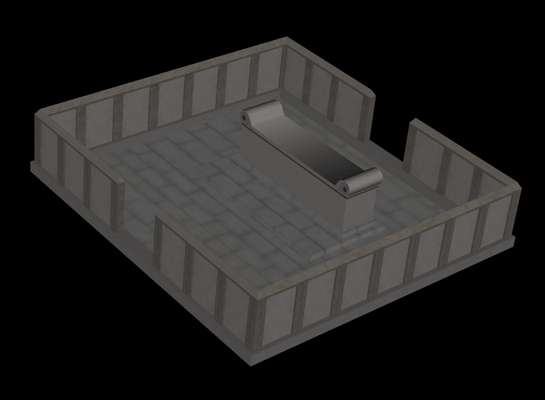Notwithstanding its fragmentary state, as 9/10 of the monument are buried under the ditch of the metropolitan railway, the Altar of the Twelve Gods did not pose any difficulties in its reconstruction, although the various theories as to the monument's evolution over time and the possible existence of sculpted decoration have led to the creation of several versions based on the initial simple model.
There are two views with respect to the dating of the Altar. According to M. Crosby [‘The Altar of the Twelve Gods in Athens’, in Commemorative Studies in Honor of Theodore Leslie Shear, Hesperia Supplement 8 (Princeton 1949), pp. 82-103, plates 11-14], its initial phase lasts until the last third of the 5th cent. BC, when the Altar is represented with a new parapet, and when, according to H.A. Thompson [‘The Altar of Pity in the Athenian Agora’, Hesperia 21 (1952), pp. 47-82, plates 14-18], we have the addition of four reliefs depicting three figures. This monument stands unaltered until the 2nd cent. AD. According to an alternative view, proposed by L.M. Gadberry [‘The Sanctuary of the Twelve Gods in the Athenian Agora: A Revised View’, Hesperia 61 (1992), pp. 447-489, plates 105-111], the monument of Phase 1 originated from the rebuilding of the original building after 480 BC, and the monument of Phase 2 with the later parapet belongs to the 4th cent. BC.
So we were led to the creation of the following models: 1. The altar in its initial phase, that is, the monument as it stood until 430 BC (according to the first view) and as it was until the 4th cent. BC (according to the second view). This model is to be used for the Classical period, if we accept the second hypothesis 2. The altar in its second phase, comprising the sculptures, which will be used for all three periods (Classical, Roman, Hellenistic), according to the first view. Although Thompson’s theory which places the reliefs in the building’s façade is clearly obsolete, as modern research attributes these sculptures to a shrine dedicated to Hercules [Harrison, E., ‘The Aged Pelias in the Erechtheion Frieze and the Meaning of the Three-Figured Reliefs’, in Clark, A.J. – Gaunt, J. – Gilman, B. (eds.), Essays in Honor of Dietrich von Bothmer, Allard Pierson Series 14 (Amsterdam 2002), pp. 137-146], we have deemed it interesting for the history of the research, but also aesthetically appealing. 3. The altar in its second phase, without the sculptures, which remains for the Hellenistic and Roman periods, if we follow the second view, or for all three periods, if we follow the first one, without, though, the addition of the sculptures, which was anyway never universally accepted, even prior to the monument's re-examination by Gadberry. We finally adopted Gadberry’s conclusions (i.e. the second view), because these were based on a stratigraphical study of the site and are accepted by almost all the scholars.
For the parapet of the first phase we have adopted the hypothesis that it resembled the one in the Monument of the Eponymous Heroes. For the parapet of the second phase we have followed the suggestions of the excavators, who broadly speaking consider it similar enough to the one of the first phase, although it was slightly repositioned and of different dimensions, now featuring two entrances, one in the east and one in its west side. Its total height has been represented as 1m approximately. In this case too, we have chosen a crowning similar to that in the Monument of the Eponymous Heroes [Μc Camp II, J.,
The Athenian Agora, A Short Guide to the Excavations,
Excavations of the Athenian Agora, Picture Book no 16, American School of Classical Studies (Princeton 2003), p. 8]. For the altar itself, we adopted a representation hypothesis based on a base surviving on the north slope of the Acropolis inside the Beulé Gate: this is made of the same material and culminates in the same helices.

Altar of the twelve gods, 3D representation

